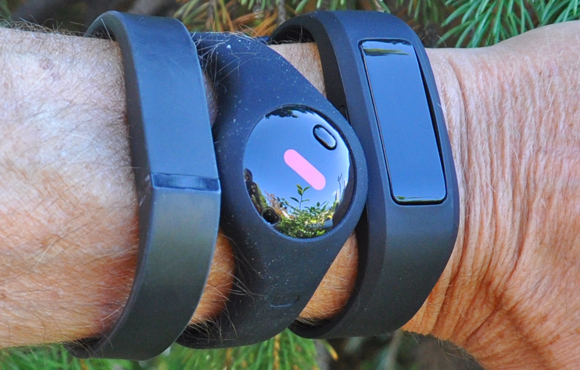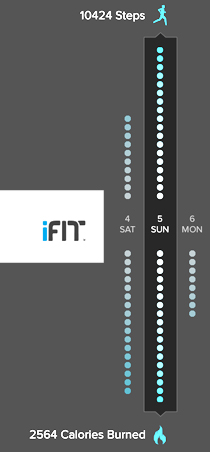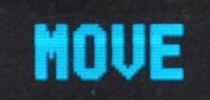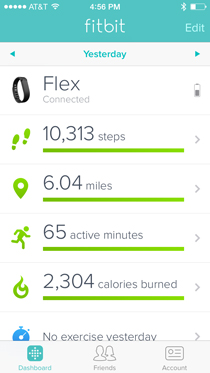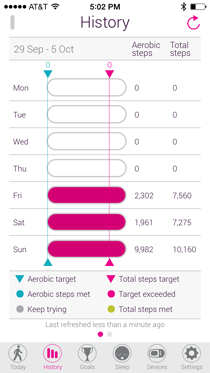Left to right: FitBit Flex, FitBug Orb, iFIT Active
October 10, 2014. If you really want to learn something new every day, strap on one of those new fitness trackers. You know, those black wristbands that people wear to learn how much, or how little, they walk each day. They count how many steps you take. They calculate the distance you walk. How many calories you burn. How many hours you sleep. Lightly. Deeply. How many times you get up each night to, well, whatever.
Maybe you are one of those wristband people. Or maybe you’re one of the many BCS subscribers who’ve written to ask, What’s the deal with these things? Should I get one? I had no idea how to answer those questions. Now I do. Because I just wore three of them nearly 24/7 for a week.
Personality Test
I thought I should evaluate a range of fitness trackers so I could make some sort of recommendation to you. Just a day into my “product test”, I realized this was really a personality test. Whether one or another or none of these is something you want or need is really all about you. About what you might actually do with some or all of the information these little bands spew out every day. And night.
The companies that make these things will tell you they’re all about Behavior Modification Techniques. Behavioral or “lifestyle” changes that are known to improve health outcomes for many people – when they’re personally guided by nutritionists, exercise physiologists, personal trainers. So the big question is: Does any of this work without the personal guidance and external enforcement? Is mere knowledge really power? It can be. Read Rick’s success story below in the right column.
Here’s the question to ponder before you go shopping. If you believe you should take 10,000 steps each day, will knowing you’re a few thousand short lead you to take more? You have to answer that one for yourself. To help you, I’ve evaluated three different products based on motivational techniques, ease of use, price and fashion. Let’s take a look at the market leader, the FitBit Flex. And compare it with two new products, the iFIT Active and the FitBug Orb.
Butt-Kicking Factor
You’re not strapping on America’s toughest trainer when you wear one of these. You’re wearing an information provider. So strange as this may seem, only the iFIT Active actually provides information you can see right on your wrist. A huge benefit. The others deliver their data only on their smartphone apps. The IFIT also delivers much more detailed information in its app than it presents on its screen in real time.
See me, feel me
The iFIT Active has a small blue LCD display that lights up when you press one of two buttons. One tells you the time of day and battery level. The other displays basic calorie, distance and step information. Much, much, much more detailed information is available from the iFIT Track app on your smartphone or your computer. If you have a wrist but you don’t always feel like dealing with your smartphone or computer, the iFIT Active is your band.
And it’s your band if you want something that’s gonna work to get your attention. About something I think is very important. Getting up off your butt every hour or so for one minute of light exercise. The iFIT Track app lets you set a “Move Time”. Say, 1 hour. Through the magic of Bluetooth (the way all these bands connect to their phone apps), the app sets your iFIT Active band to send you a message you can see and feel. If you go more than 1 hour without getting up and moving, the band vibrates and the screen lights up and blinks “MOVE”.
If you’ve been taking your dose of BCS regularly, you know I’m a big believer in Don’t Just Sit There. But even I just sit there at my desk for extended periods. Wearing the iFIT band showed me just how badly I slack off on some days. So that little hourly vibration and the flashing blue “MOVE” message on my wrist actually got me up out of my chair for a minute of moderate muscle contraction. It didn’t kick my butt, but it did rattle my wrist. Gently.
As far I know, the iFIT Active is it for real-time, sensory behavior intervention. The FitBit uses miniature LED lights to congratulate you when you reach a goal, like the moment you take your 10,000th step. You get the world’s smallest disco effect: teeny flashing lights. To be fair, the five lights are there to show progress. Tap the FitBit twice any time and one or more of the lights turns on briefly. One light for every 2,000 steps.
All three devices can track and present dozens of categories of details about your daily physical movement, calorie consumption and burning and your sleep patterns. All that data is presented … in the app. On your phone, tablet or computer screen. Go fetch. Or, in the case of the FitBit Flex and FitBug Orb, allow them to send you a daily e-mail. Time-shifted virtual nagging.
CONCLUSION: If anyone’s gonna kick your butt, it’s you. But these devices can definitely give you the data to do it with. If information motivates you, there’s a lot of potential motivation here.
User Friendliness Factor
They’re all pretty easy to strap on your wrist. Other than that, it’s all about the app. If you’re put off by too many choices, you’ll be put off by all of them. Because they’re remarkably sophisticated data acquisition and analysis devices.
If you’re familiar with installing apps on your smartphone or tablet, you’ll be on your way in a minute or two. Then it gets complicated. To take advantage of their data analysis, you have to provide a lot of data. The exercise part is relatively easy: you provide data every time you take a step. But if you want those steps converted to distance, your writsband’s app must know how far you go with each step. When you walk. And when you run.
Neither the bands nor the apps use GPS to measure distance. To test their accuracy, I ran 10K (6.25 miles) in Central Park. Including a few blocks of walking to warm up and cool down, I covered exactly 6.5 miles of known, measured distance. What did the FitBit, the iFIT and the FitBug show: 10,313 steps; 10,424 steps; 10,160 steps, respectively. Pretty close. All within about 1% of each other. But when it comes to distance – they calculate this based on your “stride length calibration” – my 6.5 miles looked different to the bands. 6.04, 4.92 and 5.42, respectively. Guess I’m better at running than calibrating.
Of course, if you want your whole health & fitness picture, you have to relate your calorie-burning exercise to your calorie-consuming dietary habits. Go figure. Because someone has to … and that’s you.
To the credit of all these products, they understand that your diet is half the problem and half the solution. If you can input enough data, they’ll crunch it for you. But having and typing all that data is a big lift. It’s why each BCS recipe comes with that little Let’s Do The Math blurb. Where I do it for you: I convert the dish’s calorie count to minutes of walking, jogging, dancing or leaf-raking. But who’s counting? Especially when it’s even more complicated: because all calories are not created equal. To feed the app with all your eating details, well, you’ll be taking on a new part-time job.
CONCLUSION: To take full advantage of a fitness tracker’s features, you’ll have to make it your best friend. Where you’re the proactive friend. Ask not what your wristband can do for you. Ask what you can do for your wristband.
Price Factor
This is easy. You can get the cheapest of the new trackers, the FitBug Orb, for $50. Buy the popular FitBit Flex for $98. Or buy the new one that gets me up and out of my desk chair every hour, the iFIT Active, for $79. All prices are valid today on Amazon.com.
CONCLUSION: I like those hourly good vibrations. But like the fitness trackers, I’m just an information provider. You’ll have to take the personality test to determine which, if any, of these devices will help you make your life better.
Fashion Factor
You’re not gonna buy one of these as a fashion accessory. The FitBit band, with no data display, looks like what I imagine you’d wear, inconspicuously, around your ankle for your probation officer. The iFIT Active lights up when you press its buttons. The orb-like FitBug with its little logo stripe aspires to cuteness in the traditional shape of a wristwatch.
If your tracker clashes with your actual wristwatch or fails to complement your bracelet, you can use the iFIT Active and the FitBug Orb with a convenient clip that comes in the package. So it’s more like a pocket protector or a phone attached to your belt.
What to do
I’m me. You’re you. I seem to need a tap on the wrist and a flashing message to get me up and out of my desk chair. If that might help you – or if occasionally or continuously streaming information about your fitness activity will helpfully inform your health – you should get one of these. Or get someone to put one in your Christmas stocking. Read “A well-informed opinion” in the right column for a success story with at least one surprise.
But wait, there’s more …
If you’re willing and able to pay for it, the folks at iFIT Active will sell you a web-enabled treadmill that works with your wristband. This is the serious butt-kicking solution. Here’s how it works:
Let’s say your wristband knows you’re you’re short of your daily goal by 2,500 steps. Via Bluetooth, it informs on you. Now the IFIT Track app on your phone knows, which means “the cloud” knows. You get home at the end of the day and turn on your iFIT treadmill. It synchs with the app in the cloud – and automatically sets up a workout to fill in your missing steps. When you hit the goal, the treadmill stops. Really.
I saw a demonstration of this at the trade exhibition where the iFIT Active band was shown. The treadmill was a groovy new “treadmill desk“. Yup. The treadmill console folds down to become a desktop. The old-fashion physical kind. So you stand and/or walk at your desk. Definitely cool. I wonder if it starts up automatically when your wrist flashes “MOVE”.
A well-informed opinion
I spoke with a longtime BCS subscriber who’s been using a FitBit for 4 months. Let’s call him Rick. He has no buyer’s remorse; I’d say he has buyer’s appreciation and bemusement.
He bought it when he and his wife began a power-walking exercise routine. Rick hoped it would provide some needed motivation to maintain the routine and increase his regular and exercise walking distances. In fact, he’s sure it helped him get his daily average up to 10,000 steps.
For the first month or so, he checked the app regularly and frequently to see his progress. Although Rick’s a techie, he found the app to be less-than-easy to use. Now he relies on a weekly e-mail report to see his FitBit data. I asked him if he continues to find it motivational. His reply: “Just putting it on my wrist every morning is a reminder to walk more than I otherwise might.” He laughed when I asked if he’d get the same benefit from a placebo wristband, all band and no tracker. He added, “At this point, it might”. I guess the point is that his fitness tracker got him to this point.
From iFIT Active’s iFIT Track app
Don’t Just Sit There
Even if you exercise vigorously for an hour, five times a week, too much sitting still significantly increases your risk of cardiovascular disease, type 2 diabetes, metabolic syndrome risk factors, and obesity. All the things you’re trying to prevent by exercising vigorously. According the journal of the American Diabetes Foundation, “the dire concern for the future may rest with growing numbers of people unaware of the potential insidious dangers of sitting too much.“
From the fitbit app
From the FitBug app
Blood Test
Here’s an extreme version of self-knowledge: Inside Tracker. A completely different approach that doesn’t want you to input lots of data. These guys want blood. Yours.
This is actually a fascinating concept. I’ll write more after I’ve had a chance to try the service myself. For now, I’ll just pass along their words about their use of “advanced bioscience”.
“InsideTracker is empowering people to take advantage of exciting advances in science, normally the reserve of of elite athletes, to make choices that optimize there personal health, longevity and wellbeing … established by leading scientists, physicians, nutritionists and exercise physiologists …
Following a simple in-home or in-clinic blood test, the platform tracks and analyzes the key biochemical and physiological markers the best scientific research has identified as most relevant to athletic performance and wellness. InsideTracker then helps people understand and interpret the results, providing science-driven nutrition and lifestyle advice …“
Ladies and gentlemen, roll up your sleeves.
The Holiday Gift for Your Wrist
The iFIT Active: $119
The FitBug Orb: $50
The FitBit Flex: $98
